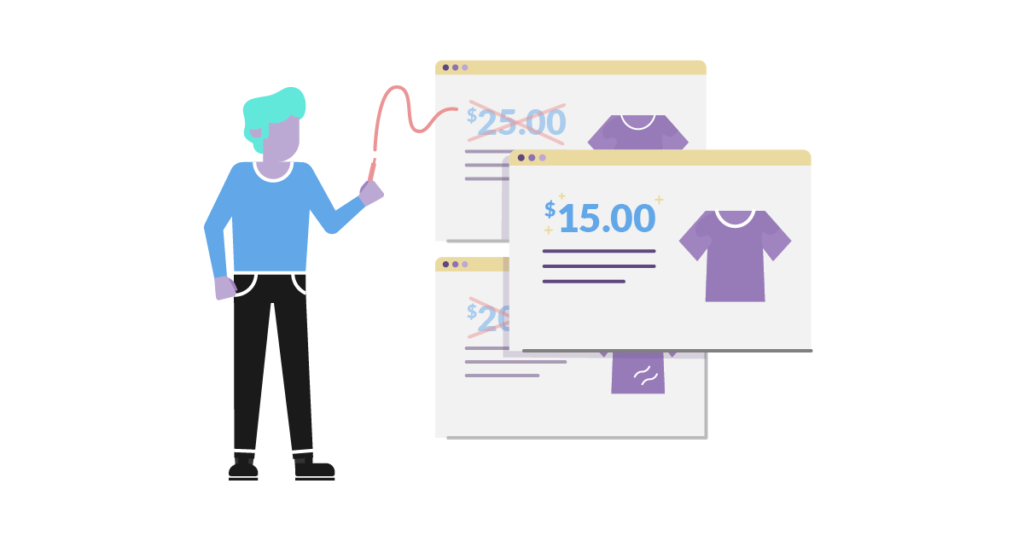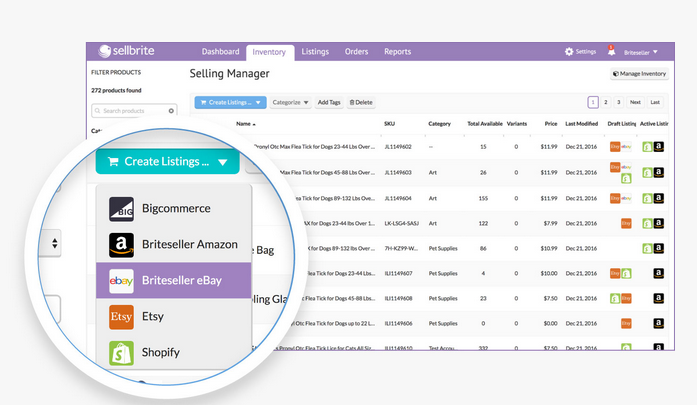Selling a lot of products at low prices is a proven profitable strategy. If you have any doubts, just look at America’s favorite discount store Walmart. They’re earning $486 billion in 2017 fiscal year revenue.
But Walmart is actually doing something really hard. Earning profits on low price items requires planning. To ensure earnings, a merchant has to selectively choose their inventory: goods with low costs and high demand to ensure high turnover. By selling low-cost goods frequently, merchants can earn profits on products at low price points.
Our data from 1,120 Sellbrite merchants shows that this planning can really pay off. We compared the revenue and product count of merchants with low-priced goods and merchants with high-priced goods to figure out the best ways for low-price sellers to build a sustainable business.
Our analysis makes it clear that merchants can’t count on offering low prices alone. Sellers also have to consider the nature of their inventory — will it cost a lot to produce? will it sell frequently?— to profit off low prices.
Let’s dive in.
Our findings: Low-price vs. high-price sellers
A merchant selling low-price items is expected to earn less on a single sale than a merchant with more expensive products. But what about overall? We wanted to see how average monthly revenue differed for these sellers to determine the best strategies for low-price merchants to stay profitable. We also wanted to check the inventory size of each seller type to determine whether low-price merchants need to sell more items to compensate for their lower prices, as we’d expect.
Using our data from 1,120 sellers, here’s how we categorized each merchant type:
- Low-price sellers: average retail selling price <$20
- High-price sellers: average retail selling price >$20
Based on these categories, we found that high-price sellers have greater average monthly revenue, and low-price sellers have a greater inventory.
High-price sellers earn more
Merchants with high-price products earn more revenue on average than merchants with low-price goods. High-price sellers earn $354,094.59 in average monthly revenue, and low-price sellers earn $165,201.48.
With these figures, high-price sellers earn 114.3% more in average monthly revenue than low-price sellers.
Low-price sellers have larger inventories
While high-price sellers have greater revenue, low-price sellers have greater inventories. High-price sellers had an average product count of 7,161, and low-price sellers had an average product count of 8,768.
With these figures, low-price sellers have inventories that are 22.4% larger than high-price sellers.
What this means for low-price sellers
The fact that low-price sellers have less revenue and more inventory than high-price sellers isn’t a good or bad thing — it just speaks to the nature of their inventory and what strategies they need to implement in order to stay profitable.
In fact, low pricing is advantageous for certain businesses, such as stores with discount-driven customers. If your business wants to focus on offering low-price items, you can build a profitable business by following our two main inventory tips:
- Keep the cost of goods low.
- Keep sales turnover high.
You have to adjust your inventory with this criteria since selling at lower prices often means dealing with lower profits per item.
You make up for your lower earnings by keeping costs low and selling frequently enough to still earn your desired gross profit.
Keep the cost of goods low
It might seem like high-price sellers profit more than low-price sellers since their average monthly revenue is over 100% greater. The truth, however, is that low-price sellers can earn just as much of a profit as merchants with high-price goods by keeping their cost of goods sold low.
Consider, for example, a high-price merchant who sells 50 goods at $200 each and a low-price merchant who sells 500 goods at $10 each. The first seller earns $10,000 in revenue, and the second seller earns $5,000 in revenue.
Suppose it cost the first seller $120 to make each product and the second seller $2 to make each product. The cost of goods sold for the first merchant would be $6,000 and $1,000 for the second merchant.
After subtracting the cost from revenue for each merchant, we can see that they each earned the same profit of $4,000, despite the large differences in revenue.
The key to keeping strong profits with low pricing is keeping costs low. Here are a few strategies for lowering your COGS as a low-price seller:
- Consider alternative ways to source your products. Sourcing methods vary widely in costs, so it’s worth exploring different options to see if you can cut back your expenses. Generally, manufacturing is the least expensive option while dropshipping is the most costly. You should also research different suppliers in your chosen method to see which offer the lowest rates while still providing high-quality service.
- Increase the efficiency of your inventory management. Inventory management errors are costly. They can lead to understocking, so you miss out on sales, and overstocking, so you spend too much on your inventory. Reduce expensive errors by keeping your inventory management efficient. If you need assistance, consider using a software program like Sellbrite.
Our tools allow you to control your entire inventory across multiple channels all from a single hub, so you can stay organized and avoid any costly inventory mistakes.
Keep sales turnover high
Our data showed that low-price seller inventories were roughly 22% larger than high-price seller inventories. This difference wasn’t a coincidence. Low-price sellers need to have high product counts because they have to make more sales than high-price merchants. By offering low prices, they’re dealing with smaller profit margins. With frequent sales, however, the small margins add up to a significant profit.
Consider the example in the section above. Suppose the low-price seller had the same product count as the high-price seller and settled on selling the same amount of 50 products. With this sale quantity, the high-price seller earns $10,000 while the low-price seller only earns $500 — only 5% of what the high-price merchant earned.
It isn’t until the low-price seller increases their sold goods amount to 500 that they earn the same profit as the high-price seller, given their cost of goods.
Ordering more inventory is easy, but selling a high quantity of your low-price products is more challenging. You have to ensure that your items have high enough demand to encourage high sales turnover. Here are a few tips to encourage a high number of purchases:
- Check competitors’ pricing. Online shoppers are savvy enough to quickly search and see which merchant is offering the best price. Identify your competitors and regularly check their pricing on marketplaces and their online stores to assess your own price. The key is to keep your rate low enough to compete with other sellers without undermining your product’s value.
- Launch a varied marketing strategy. To win a high amount of sales, you have to creatively promote your products in engaging ways. Show buyers why your product is worth purchasing with a wide variety of marketing tactics over different platforms — social media, email, podcasts. With a diverse set of strategies, you have the opportunity to experiment with different channels and see which ones work best.
Assess your inventory before you sell low
Low pricing can lead to major returns with the right inventory. Selecting low-cost goods maximizes your low-profit margins, and high-demand inventory sells frequently enough to build up revenue and generate profits at low prices.
With these inventory factors, lowering your pricing is by no means a small decision. Whether you’re lowering the costs of your goods or trying to increase turnover, give yourself enough time to secure the right inventory before making any price changes. Moving in baby steps will give you the space to measure customers’ responses to your changes and improve without drastic shifts and major losses. With the right strategies and enough time, you can build a successful business of low-price products.











